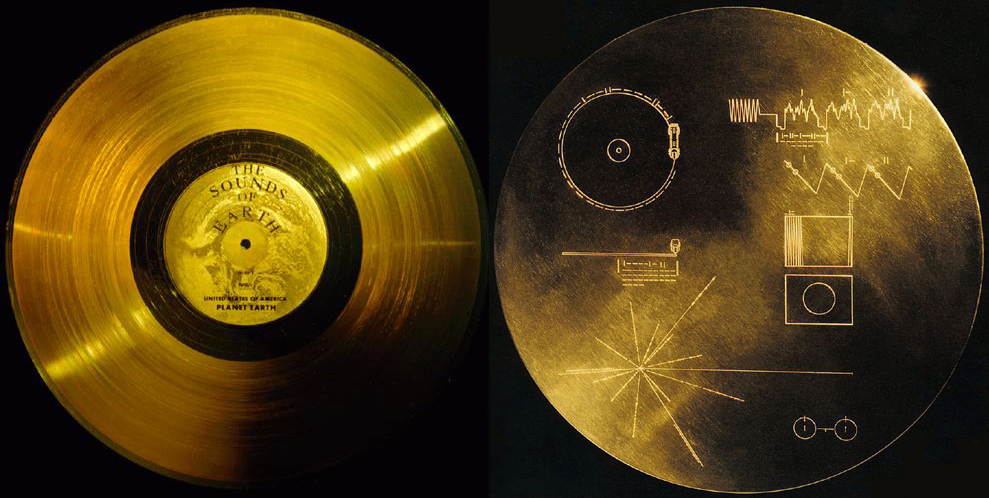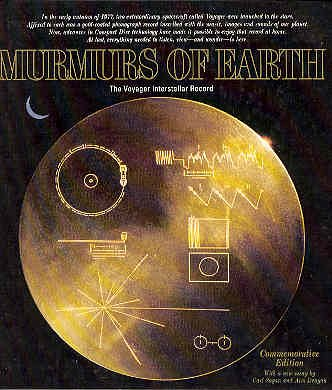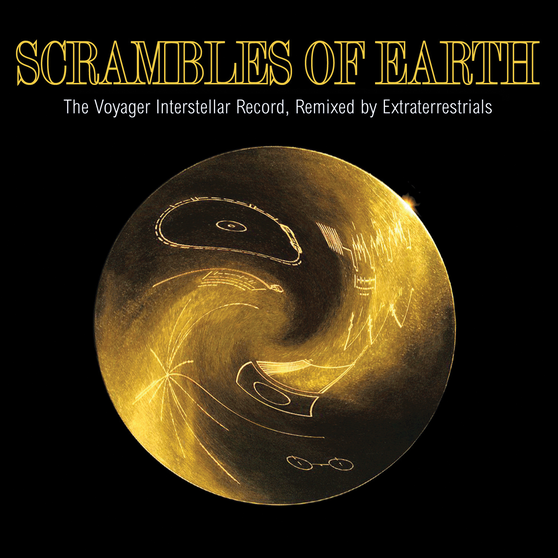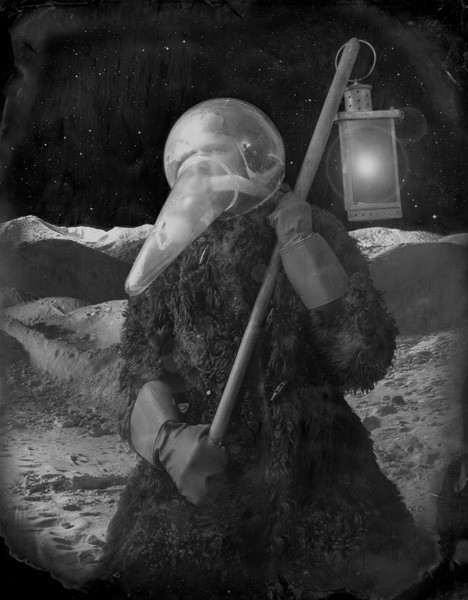Contextualizing the Context
In 2010, scientists claiming to belong to a dissenting faction of the Search for Extraterrestrial Intelligence (SETI) contacted Seeland Records. Calling themselves the Search for Extraterrestrial Intelligence in Exile, or SETI-X, the group claimed to have received an alien transmission of rearranged sound from the Voyager Golden Record, a phonograph album famously sent into outer space in 1977 on each of NASA’s two Voyager spacecraft (Figure 1). The Golden Record had been put together in the mid-1970s by a panel convened by astronomer Carl Sagan, and it held a program of sounds and music of Earth, representing to imagined aliens our planet’s soundscapes, voices, and musical traditions. [1]
Figure 1: The Voyager Golden Record. Side 1, on left, is the analog audio program. Side 2, on right, instructions to extraterrestrials on how to play the record. [2]
Sometime in the early 2000s, the scientists of SETI-X received what they believed to be an extraterrestrial response to this Record, a reply in the form of an audio collage reinterpreting the original source material. Finding their colleagues at SETI skeptical and their institutions unwilling to vouch for or make available the sounds they had received, the scientists of SETI-X at first sought contact with the principality of Sealand (Figure 2), in hopes that this micronation dedicated to stewarding and storing controversial data might channel extraterrestrial sounds to a broader public.
With no response from Sealand, SETI-X, through a serendipitous Google typo, ended up discovering an ally in Seeland Records, an independent record label known for releasing audio recordings of uncertain provenance and ambiguous legal status. While SETI-X may initially have been leery of having their research findings distributed by a record label known for publishing “copyright violation art,” in the end the organization seems to have decided that this was the only viable path toward making their findings public. [3] SETI-X’s audio archive was eventually released on a CD entitled Scrambles of Earth: The Voyager Interstellar Record, Remixed by Extraterrestrials, a somewhat more sensationalist title than SETI-X might have liked, but one that Seeland hoped could make explicit a link back to Carl Sagan, F.D. Drake, Ann Druyan, Timothy Ferris, Jon Lomberg, and Linda Salzman’s 1978 documentary book, Murmurs of Earth, about the making of the Voyager Record, and one that might also serve to make the project legible to those people familiar with Seeland’s tradition of sonic heterodoxy. The eventual CD cover for Scrambles also made visual reference to the original Murmurs package (Figures 3 and 4).
Because the scientists of SETI-X wished to remain anonymous, Seeland sought a public voice or commentator from other quarters. Because the label had in 2003 released a CD I had created, Xerophonics: Copying Machine Music, a science-and-technology themed mix of sounds of indefinite ownership (Helmreich 2003), and because I had also written about scientific notions of extraterrestrial life (Helmreich 2006), Seeland reasoned that I might be appropriately positioned to offer thoughts on the SETI-X document. They asked me to comment, which I did in a few venues (including, among other sites, the Los Angeles Daily News [Mills 2010]. More recently, such commentary has appeared, in paraphrased form, in the NASA History Program Office Newsletter [Rippert 2013]). The present essay offers a more scholarly set of reflections, although it is also intended as an introduction to a document that might more properly be permitted to speak for itself.
[1] The Record also encoded 116 images and photographs. NASA has put many of these online. In 2002, artist Steve McQueen debuted Once Upon a Time, a slideshow-installation that showed one Voyager image after another in slow, dissolving succession, to the accompaniment of recordings of glossolaliac voices (see Downey 2006).
[2] For one interpretation of the visual rhetoric of the instructions on the Record, see Helmreich (Helmreich 2011).
[3] The liner notes for Scrambles reflect explicitly on the question of who “owns” the sounds on the Voyager Golden Record. The notes also discuss whether the alleged alien remixers behind the document have fallen afoul of copyright law:
“it is apparent that the aliens are playing fast and loose with complex intercultural questions and flirting with copyright violation on an interstellar scale. In their remixes, they take unprecedented liberties with the sounds of Earth, bounding beyond even the most elementary of legal restrictions — enumerated in such cautions as the below, which appeared on a 1992 commercially available CD-ROM of the Voyager Interstellar Record:
WARNING: Unless you have the express written permission of Warner New Media, it is a violation of United States copyright law to use this product in any manner other than as an integrated presentation, to copy, photograph, transcribe, sample, print out or otherwise record in any manner the product or any portion (no matter how small) of the product, including the pictures, other graphic images, text or music contained in the product, or to synchronize or otherwise combine this product or any portion (no matter how small) of this product with any other material of any kind.
In view of this warning, listeners might reason that any earthly decryption of the alien remix should only be listened to in outer space, where this transformation was almost certainly created (and where, paradoxically — as the inscription on the Voyager record, ‘To the makers of music, all worlds, all times,’ implies — all remixes might be considered at once completely outside the law and perfectly legal. Terrestrial auditors might also keep in mind, however, that Warner’s worries rest on the assumption that the pirate aliens consistently used the same device to read as Earthlings did to write” (SETI-X 2010: booklet, references omitted).
Scholarship on the cultural, economic, and legal dimensions of musical and sonic sampling is vast. One relevant source on these topics might be McLeod and Kuenzli’s 2011 Cutting Across Media: Appropriation Art, Interventionist Collage, and Copyright Law. See also Brett Gaylor’s 2008 film, RiP!: A Remix Manifesto (Documentary/Canal D/B-Side Entertainment).
Counterfeit Space Programs
When I first encountered Scrambles of Earth, I was immediately intrigued — and quickly saw SETI-X’s document as an obvious hoax or, better, joke. But I was curious to figure out what it was a joke about. I sorted through my knowledge of other off-center, ostensibly counterfeit accounts of space science and travel. I thought of the Apollo Prophecies book, a collection of photographs documenting a mission to the moon launched by the United Kingdom during the reign of King Edward VII, from 1901-1910 (Kahn and Selesnick 2006) (Figure 5). Prophecies posed the question of how photographs of places inaccessible to everyday experience — like the Moon — function to generate their effects of empiricity (see also Messeri forthcoming). Scrambles might similarly be interpreted as an artifact through which human auditors might consider what it would take for Earthlings to accept as persuasive a document claiming to offer “empirical” evidence of extraterrestrial listeners and listening.
Then there was the 2006 mockumentary film (and musical!) Interkosmos, which reported on the existence of a top secret — and failed — East German space program dedicated to establishing socialist colonies (complete with Marxist-Leninist libraries) on the moons of Jupiter and Saturn (Finn 2006). Similar to Interkosmos’s meditation on the ideological aspirations of space programs was Tavares Strachan’s 2009 Orthostatic Tolerance, an art installation about a notional space program to be organized through a Bahamas Aerospace and Sea Exploration Center (BASEC). Orthostatic Tolerance proposed that a Bahamian space program be spearheaded by a sugarcane-fueled glass rocket made of island sand — a pitch meant to remind viewers that when state resources are tethered to big science, they necessarily carry the substance and symbolism of their place in national, colonial, and postcolonial geographies and histories.
The work of photographer Cristina de Middel in The Afronauts, a fantastical imagining of a 1960s Zambian Space Program, would seem to operate similarly (Figure 7) — although this work actually refers back to the real 1964 aspirations of Zambian school teacher Edward Mukaka Nkoloso to found a Zambia National Academy of Space Research (see Harmache 2012). The point of Afronauts, however, is not to designate as somehow deficient those space programs that unfold far from centers of technological power, marking them as somehow akin to space-age cargo cults, but rather to point out that the programs of dominant spacefaring nations are also always political, social, economic, even ethnic projects — as Gil Scott-Heron’s “Whitey on the Moon” proto-rap from 1970 made clear for the U.S. space program (Lewis 2012). Sun Ra’s Space is the Place, a 1972 film that imagined a Moog synthesizer-powered black space program, is a more sonically tuned example, representing a utopian critique of the all-too-Earth-bound space fantasies of mostly white people (see Coney 1974; Womack 2013). These reimagined space programs and projects all query what the “real” ones are all about.
It occurred to me the SETI-X project was asking questions analogous to those posed by some of these examples, particularly the mockumentary ones, using similar strategies: combinations of the obvious, the obscure, and the obfuscatory. The liner notes to the Scrambles of Earth CD included a number of citations to legitimate scientific papers on interstellar communication, although they also pointed to secondary sources difficult to pin down with respect to their claims about the truth status of extraterrestrial messaging, and even one of the legitimate papers, Michael Lachmann, M.E.J. Newman, and Cristopher Moore’s “The Physical Limits of Communication, or Why Any Sufficiently Advanced Technology Is Indistinguishable from Noise,” from the American Journal of Physics, was quite inscrutable in its implications. One of my own publications (on astrobiology) was referenced, too, though in a quite different context than I had intended (Helmreich 2006). Had I been of a paranoid disposition, I might have seen this citation as an invitation to a Philip K. Dick-style epiphany, in which I might imagine that I myself had been somehow implicated in the SETI-X project before encountering it! Or I might have persuaded myself that this was a joke that was actually carrying a genuine alien message, secreted within the clothing of an inept hoax. Maybe if enough people began to take this project seriously, it would actually force itself to become true! Shortly after the release of Scrambles, the Yale News reported that, “Some scientists anticipated a discovery like this months ago, when Voyager’s data stream back to Earth suddenly changed. British newspaper The Daily Telegraph reported that Hartwig Hausdorf, a German academic, believed that something must have hijacked or reprogrammed the spacecraft” (Defiesta 2010). And in the pages of Feminist Theory, Sarah Kember (Kember 2011) reported on SETI-X in a meditation on how scholars might think newly of agency and otherness, and she wrote, quite straightforwardly, that she saw no reason to disagree with SETI-X’s claims. A Wikipedia entry on trends in the 2010s reported, under its “Music” heading, that “Interstellar music was invented in November 2010”, an indication that more and other people had been listening (with the word “invented” leaving it unclear who the authors thought were the inventors of the genre in question). The more I looked around, the more it seemed that the world was beginning to be populated by claims here and there that took the SETI-X project at face value. [4]
[4] And compare Trevor Paglen’s Last Pictures project (Paglen 2012), which saw this artist-geographer team up with engineers and space scientists at MIT in order to launch into geostationary orbit a satellite containing photographs of Earthly life — photographs, unlike those optimistic and didactic images encoded on the Voyager Record, that Paglen selected so that they might carry rather confusing and often grim meanings.
The Sound of Alien Ears
Silly joke, serious joke, or possible stealth message from aliens, I find it most useful to think about this object as a kind of sonic science fiction. As a work of science fiction, the disc calls attention to the weirdness of the original Voyager Interstellar Record, an artifact which, on its own, would make a fascinating document for an introductory class in media studies, global American history, or ethnomusicology, perhaps prompting students to puzzle through their assumptions about aliens, humans, culture, and science. Is the Voyager Record a utopian call to cosmic companionship? Is it a weird, ethnocentric angle on human cultural variety? (The answer to this is almost certainly yes, since ethnomusicologists Robert Brown and Alan Lomax participated in selecting the tracks, ostensibly to avoid the ethnocentrism that would have followed from sending only Bach, but with the effect of reproducing ethnomusicology’s highly hierarchical 1970s map of human difference [see Nelson and Polansky 1993]). Is the Golden Record a neocolonial demand for tribute? Is it a philosophical failure to recognize the provincial character of universalistic claims? The liner notes to Scrambles of Earth — and, more, the audio — open up all of these questions. There are surely more. Whether hoax, joke, or actual alien artifact, Scrambles of Earth is clearly a data point pointing to the formation of what anthropologist Debbora Battaglia (Battaglia 2005) has called “E.T. culture.”
Thinking of Scrambles of Earth through the kinds of questions raised at the Freie Universität Berlin “Sounds of Space” workshop of December 2012 — out of which most papers in the present special issue of The Journal of Sonic Studies emerge — I have come to think of the scientists of SETI-X as pressing us to consider what extraterrestrial habits of hearing or listening might be like — habits at once material and embodied as well as fully situated within what, for lack of a better vocabulary, we might think of as “social” and “cultural” worlds (realizing that these concepts are themselves Earthly inventions — and rather recent and parochial ones at that).
One could think, then, of Scrambles of Earth as proposing a “sound from space” that could be added to the taxonomy presented in James Wierzbicki’s “The Imagined Sounds of Space” (Wierzbicki 2014). Wierzbicki names various sorts of “sounds from space” present in space-themed movies. His discussion is tied to more-or-less “musical” compositions, but thinking about sound more generally, I wish to pick out from Wierzbicki’s essay four “sounds of space” that strike me as especially common in imaginations of spacy soundscapes (and not only in film):
1. The sounds of travel through outer space — the propulsive force of spaceships, for example, as in Flash Gordon or Star Wars.
2. The sound of “futuristic” technologies, “made up of bleeps and blips that cover a wide pitch range and are devoid of recognizable rhythmic patterns.”
3. The sound of alien atmospheres, or “interplanetary sound” — something like the sound of alien atmospheres, as in 1961’s The Phantom Planet.
4. The sound of signals from outer space (extraterrestrial communiqués, often resembling radio or Morse-code styled transmissions).
The SETI-X CD suggests a fifth category of “sound from space”: the sound of alien ears, listening. [5] What, SETI-X asks, would it be like to hear as an alien?
Such a question assumes, of course, that the word “hear” maps onto extraterrestrial sensoria — a huge assumption, since “hearing” is itself far from a universal experience, even among humans. One might recall such philosophy-of-mind writing as Thomas Nagel’s 1974 “What Is it Like to Be a Bat?”, a thought experiment that asks whether it is ever possible fully to occupy the subjective experience of an Other, particularly an other, like a bat, with very different sensory affordances — such as the capacity for using echolocation to move about the world (and consult Hughes 1999). The question about alien hearing also demands that we ask what sound is in the first place. The first approximation is easy: it is a subjective experience for some inhabitants of the dominion of living things and not at all a universal, absolute thing in the universe. Even on Earth, there are many sorts of hearing — mammalian (both “natural” and technologically augmented), reptilian, crustacean, insect, and computational-algorithmic. There may be more.
But closer attention to Scrambles generates the question of what is it we hearing people are hearing when we listen to alien sounds (or more precisely, when we listen to transcriptions of alien transformations of human auditory data into something else, with that something else then transduced back into the audio register). Many possibilities suggest themselves. A spectrographic analysis of the tracks on Scrambles reveals that the program contains sounds above the 19KHz range, a zone outside the range of most hearing persons. There is, of course, no reason to believe that aliens carve up the frequency range in same way as do hearing humans, so we may not even be listening to Scrambles properly when we seek to commune with sounds interpreted by alien ears (it may also be that the 19KHz threshold is not even meaningful for the aliens, since they may have been decoding in an entirely different domain than the vibratory). [6] There are also tracks that seem to demand a different auditory milieu altogether; some are apparently meant to be heard in a uranium atmosphere. There are tracks that appear to take one selection on the original record and use it as information to control another … are we meant to listen to this? [7] Still others compress all the sound of the original Record into a single burst. What, such artifacts ask, if sound does not always unroll itself across time, but manifests in instantaneity, in simultaneity? What if aliens can listen to everything at once? Is it possible to hear in two different temporal directions at the same “time”? Is all the information on the “remix” “auditory”? Is some meant to be translated into light? Into taste? None of this is clear.
If you click on the link at the end of this paragraph, you can explore these questions for yourself. Scrambles of Earth presents the sound of sound as it might be heard by alien ears, translated back into something humans might listen to [8] — even as it may not be that this is sound meant for human Earthlings at all. Judge for yourself by linking, looking, and listening here.
[5] There may even be a prior question, about alien music. One might specify the query further: if aliens developed anything akin to the highly mathematized apparatus that suffuses classical Western music, though had different sensibilities about what counted as consonance and dissonance, what might their musical productions sound like? For one speculative answer, listen to Sethares, William (2002). Exomusicology [CD]. Cotuit, MA: Odyssey Studios.
[6] A possibility entertained in a short documentary about the Scrambles project.
[7] For space sounds not meant for humans, look to accounts of the sound of Voyager leaving the heliosphere, a sound only available to human ears through making data from the Plasma Wave Science instrument on Voyager vibrate in the audio register:
Strictly speaking, the plasma wave instrument does not detect sound. Instead it senses waves of electrons in the ionized gas or “plasma” that Voyager travels through. No human ear could hear these plasma waves. Nevertheless, because they occur at audio frequencies, between a few hundred and a few thousand hertz, “we can play the data through a loudspeaker and listen,” says Gurnett. “The pitch and frequency tell us about the density of gas surrounding the spacecraft.” When Voyager 1 was inside the heliosphere, the tones were low, around 300 Hz, typical of plasma waves coursing through the rarified solar wind. Outside, the frequency jumped to a higher pitch, between 2 and 3 kHz, corresponding to denser gas in the interstellar medium (NASA, Nov 1, 2013)
[8] In her dissertation on the scientific search for life beyond Earth, anthropologist Klara Capova (Capova 2013) classifies three modes through which searches for life have been conducted:
Messaging
Listening
Exploring
All of these modes of attention to the cosmos feature the “alien” as “the missing subject.” Scrambles of Earth is something like the sound of that missing subject listening.
See also the work of anthropologist Kathryn Denning on “extraterrestrial others,” particularly her 2012 “Learning to read: Interstellar message decipherment from an anthropological perspective.”
References
Battaglia, Debbora (2005). E.T. Culture: Anthropology in Outerspaces. Durham: Duke University Press.
Capova, Klara (2013). “The Charming Science of the Other: The Ethnography of the Scientific Search for Life beyond Earth” (Dissertation). Durham: Durham University.
Coney, John (Director). (1974). Space is the Place, featuring Sun Ra [movie]. United States: North American Star System.
Defiesta, Nick (2010). “Review of Scrambles of Earth.” Yale News, October 15.
Denning, Kathryn (2012). “Learning to Read: Interstellar Message Decipherment from an Anthropological Perspective.” In Douglas A. Vakoch (ed.), Archaeology, Anthropology, and Interstellar Communication (95-110). Washington, DC: NASA Office of Communications, Public Outreach Division, History Program Office.
Downey, Anthony (2006). “Miniatures: Steve McQueen, ‘Once Upon a Time’, South London Gallery, 17 September–7 November 2004.” Journal of Visual Culture 5/1: 119-125.
Finn, Jim (Director). (2006). Interkosmos [DVD]. United States: Facets Multimedia.
Gaylor, Brett (2008). RiP!: A Remix Manifesto [film]. Canada: Documentary/Canal D/B-Side Entertainment.
Harmache, Coralie (2012). “The Almost Forgotten Zambian Space Odyssey.” Motherboard, November 21.
Helmreich, Stefan (2003). Xerophonics: Copying Machine Music [CD]. Seeland Records.
Helmreich, Stefan (2006). “The Signature of Life: Designing the Astrobiological Imagination.” Grey Room 23/4: 66-95.
Helmreich, Stefan (2011). “The Inner Sleeve: The Voyager Interstellar Record.” The Wire 324: 77.
Hughes, Howard C. (1999). Sensory Exotica: A World Beyond Human Experience. Cambridge, MA: MIT Press.
Kahn, Nicholas and Richard Selesnick (2006). The Apollo Prophecies. New York: Aperture.
Kember, Sarah (2011). “No Humans Allowed? The Alien in/as Feminist Theory.” Feminist Theory 12/2: 183–199.
Lachmann, Michael, M. E. J. Newman, and Cristopher Moore. (2004). “The Physical Limits of Communication, or Why Any Sufficiently Advanced Technology Is Indistinguishable from Noise.” American Journal of Physics 72: 1290–1293.
Lewis, Cathleen (2012). Okudzhava and Scott-Heron. The Social Critique Soundtrack of the Space Race. Lecture at Sounds of Space workshop, Freie Universität Berlin, Berlin, Germany, November 30-December 1.
Macauley, William R. (2012). “Inscribing Scientific Knowledge: Interstellar Communication, NASA’s Pioneer Plaque, and Contact with Cultures of the Imagination, 1971-72.” In Alexander C.T. Geppert (ed.), Imagining Outer Space: European Astroculture in the Twentieth Century (285-303). Basingstoke: Palgrave Macmillan.
McLeod, Kembrew and Rudolf Kuenzli (eds.) (2011). Cutting Across Media: Appropriation Art, Interventionist Collage, and Copyright Law. Durham: Duke University Press.
Messeri, Lisa (forthcoming). Placing Outer Space: An Earthly Ethnography of Other Worlds. Durham: Duke University Press.
Mills, Michelle J. (2010). “The Space Travelin’ Gold Records: Was Anyone Listening?” Daily News, Los Angeles.
Nagel, Thomas (1974). “What is it Like to Be a Bat?” The Philosophical Review 83/4: 435-450.
Nelson, Stephanie and Larry Polansky (1993). “The Music of the Voyager Interstellar Record.” Journal of Applied Communication Research 21/4: 358-375.
Paglen, Trevor (2012). The Last Pictures. Berkeley: University of California Press.
Sagan, Carl, F.D. Drake, Ann Druyan, Timothy Ferris, Jon Lomberg, Linda Salzman Sagan (1978). Murmurs of Earth: The Voyager Interstellar Record. New York: Random House.
Scott-Heron, Gil (1970). “Whitey on the Moon.” On Small Talk at 125th and Lenox [LP] New York: Flying Dutchman Records.
Sethares, William (2002). Exomusicology [CD]. Cotuit, MA: Odyssey Studios.
Rippert, Katja (2013). “Workshop Report: The Sonic Dimension of Outer Space, 1940-1980.” News & Notes, NASA History Program Office 30/2: 17-20.
Wierzbicki, James (2014). “The Imagined Sounds of Outer Space.” Journal of Sonic Studies 8/1.
Womack, Ytasha L. (2013) Afrofuturism: The World of Black Sci-Fi and Fantasy Culture. Chicago: Lawrence Hill Books.








